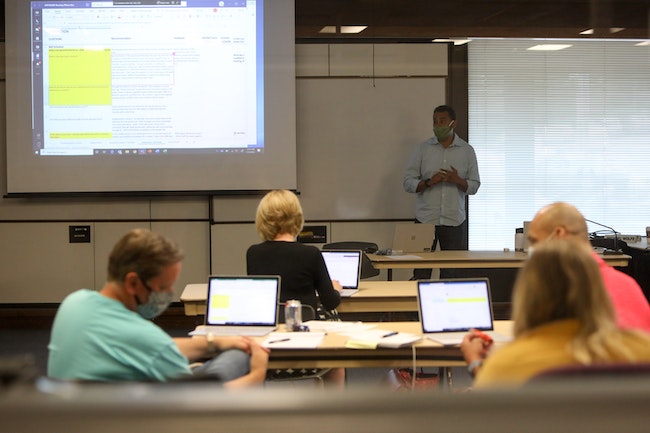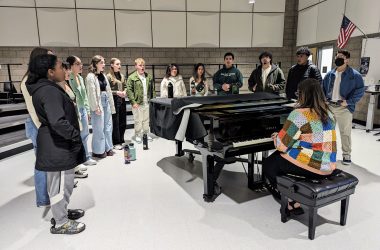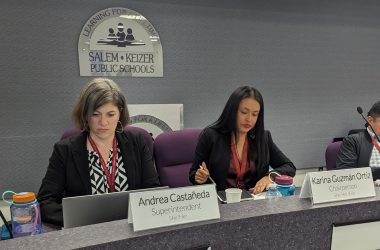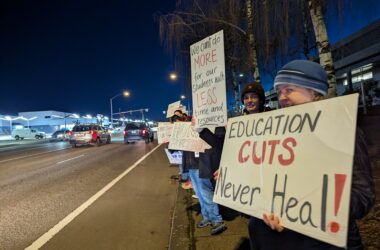 Salem-Keizer school district administrators meet to plan for the upcoming school year on Friday, July 10. (Amanda Loman/Salem Reporter)
Salem-Keizer school district administrators meet to plan for the upcoming school year on Friday, July 10. (Amanda Loman/Salem Reporter)
Local educators are increasingly wary of returning to the classroom in the fall, with many saying they have no clear information new health protocols or what will happen when a student or teacher becomes infected with the coronavirus.
Their concern echoes heightened warnings from health officials and Gov. Kate Brown, who this week restricted private indoor gatherings of Oregonians to 10 or fewer people based on the virus’ increasingly rapid spread. Brown on Thursday said school this fall “will not look like a normal year” in a press release.
“It does beg the question of how do you have safe schools when the governor’s telling the rest of the state to only have 10 people inside,” Superintendent Christy Perry said in an update to the Salem-Keizer School Board on July 14.
Administrators said they don’t have many of the details they need to plan, like state funding levels for the coming year. Many of the protocols they’re required to follow for classrooms, like daily temperature checks and logs for contact tracing, will require more people at the same time schools are cutting budgets.
Parents too have been increasingly vocal about intentions to return to classrooms, writing to the school board and flooding the district’s Facebook page with comments and questions. Some are urging schools to reopen full-time, saying distance learning was disastrous for their children or questioning why they should pay taxes if schools will only be open a few days a week. Others say opening classrooms again is condemning both teachers and students to die from Covid.
Teachers say they’re caught in the middle. Nearly all who took a district survey at the end of the school year reported they didn’t feel they could adequately help struggling students in an online setting.
“I’d rather be at school than anywhere else in the world. It’s the best job and where I feel the most comfortable,” said Noah Hall, a fifth-grade teacher at Brush College Elementary School. Seen through a sliding glass door, Noah Hall, wife Jessica and children Evan, 6, and Ruby, 2, sit at the kitchen table of their Salem home on Wednesday, April 23. The Halls are both elementary school teachers (Amanda Loman/Salem Reporter)
Seen through a sliding glass door, Noah Hall, wife Jessica and children Evan, 6, and Ruby, 2, sit at the kitchen table of their Salem home on Wednesday, April 23. The Halls are both elementary school teachers (Amanda Loman/Salem Reporter)
But teachers also question how classroom instruction can be safely resumed when Covid infection rates and hospitalizations are rising across the state.
“There’s more cases now than there were when schools shut down on March 13,” said Megan White, a third-grade teacher at Auburn Elementary School.
If a student or educator tests positive for the virus, state guidelines would require the entire class to stay home for 14 days. That means in-person schooling could quickly shift back to online class if even a few students fall ill.
At a July 10 planning meeting, district administrators estimated about 15% of employees won’t return to school because they’re at high risk for the virus, live with someone who is or can’t find childcare.
Hall is among those teachers. He’s diabetic and has asthma and a reactive airway disorder, putting him at high risk for Covid. He plans to teach online and enroll his son in the district’s online academy for the fall.
Some teachers who initially said they were willing to return are now reconsidering.
White said she’s at high risk for a serious case of the virus because of underlying health conditions.
In a late June district survey, she said she’d teach in-person school, which works better for her students. But with the continuing rise in new cases, she feels the district would be most effective focusing on making a better online learning system for everyone, rather than making detailed plans for classroom teaching that might never materialize.
“I feel like everyone’s at risk,” she said.
The debate over school reopening has become heated over the past two weeks as the Trump administration has pushed schools to fully reopen, and teachers unions across the U.S. have pushed back.
Earlier this week, the Woodburn Education Association said 81% of the district’s teachers voted against returning to school in the fall, citing the city’s high rate of Covid infection.
Large schools districts around the U.S., including Los Angeles, San Diego, Atlanta and Dallas, have announced in recent days they won’t reopen schools at the start of the year.
Chunhuei Chi, director of Oregon State University’s Center for Global Health, said other countries were able to keep schools open during the Covid pandemic or reopen them after brief closures.
Countries that have done so successfully, like Taiwan, had relatively low rates of virus transmission and robust health measures inside schools to prevent infection and rapidly isolate anyone testing positive, he said.
Chi said Oregon’s infection rates make opening in person “very risky” and said he doesn’t think most districts can implement the sort of health measures needed.
As scientists and public health workers have learned more about how the virus spreads, he said it’s become clear that indoor, poorly-ventilated spaces, like schools with aging heating systems, pose a high risk.
“The highest risk of spread is aerosol, and aerosol can occur in any indoor condition where it’s not well ventilated. When aerosol happens there’s no such thing as a safe distance,” he said.
In that environment, he said masks are “critical, far more important than social distance.”
Oregon guidelines require teachers to wear face coverings in the school building only if 6 feet of distance can’t be maintained. At this point, students aren’t required to wear coverings.
Scientific research has established that children rarely become seriously ill from the virus and have low mortality rates. But scientists are still unsure how effectively children might spread the virus to adults in school and at home. Other countries that have reopened schools saw little or no transmission, but also had much lower rates of disease in the community than Oregon currently does, Chi said.
Katrina Rothenberger, public health division director for Marion County, said the age group from 10 to 19 last week was show the fastest increase in the rate of infections. That shows, she said, that children do get the virus.
But so far, the county hasn’t seen outbreaks inside childcare facilities that have remained open during the pandemic, suggesting health protocols are working to prevent young children and those caring for them from falling ill.
In Salem-Keizer, educators met virtually earlier this week to question district administrators about plans for the fall.
Cortney Clendening, a first-grade teacher at Clear Lake Elementary School and union building representative, said she recorded over a dozen pages of questions from the meeting, many of which administrators couldn’t answer.
Those include concerns around sick leave, like whether teachers will be paid if they get Covid at school or have to quarantine at home because a student tests positive for the virus.
She said many teachers worry the extra work of sanitizing classrooms will fall on them rather than custodial staff, since some schools don’t have a daytime custodian. They’re also skeptical teachers will have the supplies they need to stay safe in class.
“Right now some of the medical providers are not getting (personal protective equipment) but the district’s going to provide us with stuff? Where are they going to get it?” she said.
District administrators are still planning for a hybrid form of school in the fall.
Most students would attend school in person two days per week, completing online work at home other days. Kindergarten through second-grade students would have four days per week, and special education and English language learning students might have more time in schools to help.
But assistant superintendent Kraig Sproles acknowledged that if current trends continue, in-person school may have to wait.
“We realize that if the number of COVID cases continue to increase and we cannot safely bring students and staff back to school, we will need to provide excellent distance learning for our students,” he said in an email Friday.
Hall said both as a teacher and parent, he thinks online school will work better in the fall because there’s been more time to plan and teachers can hold students accountable for completing work.
But he’s eager for a time when it’s safe for him to return to the classroom.
“I really wish that we could be there and be with our kids and teach them. That’s my passion,” he said. “I don’t think anybody’s going to be able to make a decision until really close to September.”
SUPPORT ESSENTIAL REPORTING FOR SALEM – A subscription starts at $5 a month for around-the-clock access to stories and email alerts sent directly to you. Your support matters. Go HERE.
Contact reporter Rachel Alexander: [email protected] or 503-575-1241.

Rachel Alexander is Salem Reporter’s managing editor. She joined Salem Reporter when it was founded in 2018 and covers city news, education, nonprofits and a little bit of everything else. She’s been a journalist in Oregon and Washington for a decade. Outside of work, she’s a skater and board member with Salem’s Cherry City Roller Derby and can often be found with her nose buried in a book.









